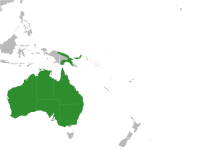
Back سحالي عديمة السيقان Arabic سحالى عديمة السيقان ARZ Pulcuqayaqlar Azerbaijani Змийски гущери Bulgarian Pygopodidae CEB Finnefodet øgle Danish Flossenfüße German Pygopodidae Spanish Pygopodidae Basque مارمولکان استرالیایی Persian
| Pygopodidae | |
|---|---|

| |
| Lialis burtonis | |
| Scientific classification | |
| Domain: | Eukaryota |
| Kingdom: | Animalia |
| Phylum: | Chordata |
| Class: | Reptilia |
| Order: | Squamata |
| Superfamily: | Pygopodoidea |
| Family: | Pygopodidae Boulenger, 1884[1] |
| Subfamilies | |
|
2, See text | |

| |
| Geographic range of the family Pygopodidae in Australia and New Guinea. | |
Pygopodidae, commonly known as snake-lizards, or flap-footed lizards, are a family of legless lizards with reduced or absent limbs, and are a type of gecko.[2] The 47 species are placed in two subfamilies and eight genera. They have unusually long, slender bodies, giving them a strong resemblance to snakes. Like snakes and most geckos, they have no eyelids, but unlike snakes, they have external ear holes and flat, unforked tongues.[3] They are native to Australia and New Guinea.[4]
Pygopodids have no fore limbs at all, but they do possess vestigial hind limbs in the form of small, flattened flaps.[3] These may have some role in courtship and defensive behaviour, and may even aid in locomotion through vegetation. Some species are insectivorous burrowing animals, but others are adapted to moving through dense spinifex or other vegetation.
- ^ "Pygopodidae". Dahms Tierleben. www.dahmstierleben.de/systematik/Reptilien/Squamata/Gekkota/Pygopodidae.
- ^ Gamble, Tony; Greenbaum, Eli; Jackman, Todd R.; Russell, Anthony P.; Bauer, Aaron M. (June 27, 2012). "Repeated origin and loss of adhesive toepads in geckos". PLOS ONE. 7 (6): e39429. Bibcode:2012PLoSO...739429G. doi:10.1371/journal.pone.0039429. PMC 3384654. PMID 22761794.
- ^ a b Bauer, Aaron M. (1998). Cogger HG, Zweifel RG (eds.). Encyclopedia of Reptiles and Amphibians. San Diego: Academic Press. pp. 150–152. ISBN 0-12-178560-2.
- ^ Cite error: The named reference
Website 1was invoked but never defined (see the help page).
© MMXXIII Rich X Search. We shall prevail. All rights reserved. Rich X Search